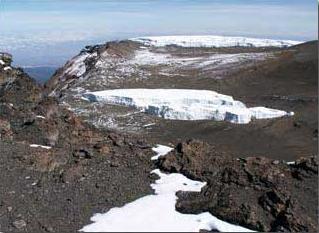Every year, 31,000 climbers fly from around the globe to northeastern Tanzania to climb Mount Kilimanjaro. It’s easy to see why. From miles away, the solitary volcano rises from the plains and dominates the landscape, cutting through the clouds and peaking in a flattop.
Most climbers trek up the Marangu Route, which has earned the name “the Coca-Cola Route” after the hordes of Americans who use the route. The 12 members of my hiking party are looking for something more remote, and we find it on the east side of the mountain.
Our path is the Rongai Route, close to the Kenyan border. This relatively undisturbed route promises majestic views and a buffet sampling of the African wild, as it cuts through verdant jungle, alpine desert and glaciers.
We start our 10-day trip from the Kibo Hotel at the base of the mountain, in the town of Marangu. Jimmy Carter stayed here in 1988 when he climbed Kilimanjaro, but the cozy compound, draped with autographed jerseys of those who’ve summited, feels anything but presidential.
It’s a relic from the 1930s with aged tin roofs and, between the springy twin beds and the dim corridors, it has a distinct dormitory feel. Here at the foot of the mountain, the thick palm trees still tower over us.

Hikers close in on Uhuru Peak, the summit of Kilimanjario.
In the morning we pack the Land Rovers and head out on rocky, red clay roads. For three hours, the extreme vibration of the truck makes me feel like I’m in a hardware store paint shaker. Forehead pressed to the window, I take in the banana fields, and wave to barefoot children who line the road dressed in bright colors, on their way back from church.
As we get closer, there’s something out of place about the mountain. It sticks out from the landscape like the monolith from director Stanley Kubrick’s movie 2001: A Space Odyssey, and it’s hard for any of us to take our eyes off it.
For an amateur hiker like me, Kilimanjaro offers a unique opportunity. At 19,340 feet (5,895 m), it’s the highest mountain in Africa, and the highest peak in the world that’s not part of a mountain range. Situated just south of the equator with a relatively gentle incline, it’s also one of the few mountains in the world this high that you can ascend without technical climbing skills.

From the crater rim, hikers get a look into the
ash pit of the dormant volcano.
During our previous briefing by the head guide at the hotel, we’ve been told we can all make it, but I’m still nervous, and unsure about how I’m going to adapt to the altitude.
That’s the biggest challenge of the mountain, and for the past six months I’ve been training to prepare myself. One rule of thumb is that you should be able to run for a half-hour straight before you attempt the climb. My training consisted of runs and trips to the gym, but you can do anything that will build up your cardiovascular endurance.
It’s a slow pace, but if you go on an organized tour, you’ll likely be hiking for four to eight hours a day (and as many as 17 hours on the summit day). There’s also a lot of required equipment. Your travel agent should provide a list of recommended gear. Follow it to the letter. I did, and was thankful later.

Sunrise over Mawenzi as seen from Kibo, the first sun hikers
have seen after an all-night trek to Gillman’s Point.
To see how you’ll adapt to the altitude, you can try to climb a high mountain, but if you don’t have one nearby, just try to build up your endurance. A word of caution: Those who are hypoglycemic or have low blood pressure should consult a doctor before committing to this. The altitude will affect you more than others. That being said, my climbing team ranges from 25 to 64 years old, and includes a wide span of fitness levels.
On the plus side, if you go on an organized tour, you’ll have help. The porters outnumber our hiking team by about three to one. These guys are mountain goats, putting us all to shame by hauling up tents and cooking equipment twice as fast as we can climb, so by the time we arrive, all of our sleeping tents and the larger mess tent are already dotted about the campsite. The guides and porters are all extremely friendly, and they provide some essential encouragement along the way.
After unpacking the Land Rovers, we start out at an unmarked trailhead with a view of Kenyan farmland below us. It’s sunny and hot, and we strip down to T-shirts and shorts before walking slowly through a half-mile (800 m) of maize and sunflower crops. The stalks are as tall as us, and I occasionally spot a bulge of ripening maize in its husk.
Previous: Peru lures wealthy tourists